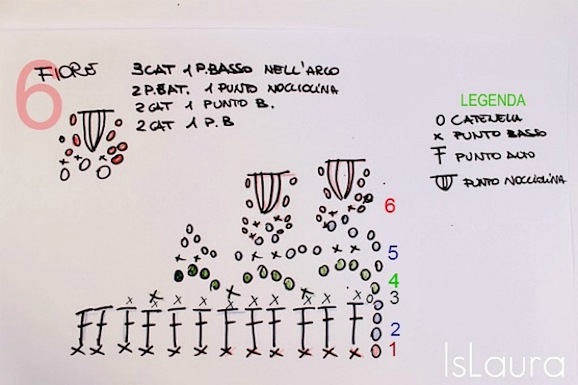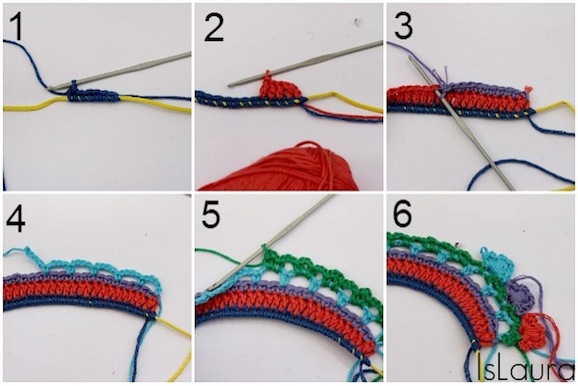Ogni riga si terminerà con un punto bassissimo, tagliando il filo e sfilandolo.

I punti sono quelli base: catenella, punto basso, il bassissimo e punto alto a parte i fiorellini finali che verranno eseguiti con colori diversi e alternati. Il punto centrale contrassegnato da 4 aste con una barra in alto è il punto nocciolina o punto stitch, filo sull’uncinetto, infilare l’uncinetto nel punto di base, un’altra volta filo sull’uncinetto, questo per 4 volte e chiudere poi tutti i punti insieme.
Riga 1: 1 cat. una serie di punti bassi lavorati sulla coda di topo. Il numero è variabile a seconda della lunghezza desiderata, l’importante che siano multipli di 4.
Riga 2: 3 cat. e continuare con una serie di punti alti.
Riga 3: 1 cat. e una serie di punti bassi.
Riga 4: 5 cat. 1 punto basso saltando 2 punti bassi della riga sottostante, continuare con 4 cat. e 1 punto basso sempre saltando 2 punti bassi. Proseguire sino al termine della riga.
Riga 5: 3 cat. nell ‘archetto sottostante lavorare: *1 p.basso, 3 cat., 1 p.basso, 3 cat. sino ad arrivare all’altro archetto*, ripetere da *a* sino al termine.
Riga 6: su ogni archetto della riga 5 creare i fiori in colori differenti. 3 cat. 1 punto basso, 2 cat. 1 punto nocciolina, 2 cat. 1 punto basso, 2 cat, 1 punto basso. Chiudere con un punto bassissimo, tagliare e sfilare il filo. Ripetere ogni fiore su ogni archetto della riga precedente.

Qui sopra potete vedere i vari passaggi fotografati.
Quando si è giunti al termine fissare, con l’aiuto dell’ago, tutti i fili.
Ho voluto aggiungere al centro dei fiorellini tanti fili passati attraverso il foro e fermati tra loro
 Occorre veramente pochissimo tempo, ma la soddisfazione è
Occorre veramente pochissimo tempo, ma la soddisfazione è

I punti sono quelli base: catenella, punto basso, il bassissimo e punto alto a parte i fiorellini finali che verranno eseguiti con colori diversi e alternati. Il punto centrale contrassegnato da 4 aste con una barra in alto è il punto nocciolina o punto stitch, filo sull’uncinetto, infilare l’uncinetto nel punto di base, un’altra volta filo sull’uncinetto, questo per 4 volte e chiudere poi tutti i punti insieme.
Riga 1: 1 cat. una serie di punti bassi lavorati sulla coda di topo. Il numero è variabile a seconda della lunghezza desiderata, l’importante che siano multipli di 4.
Riga 2: 3 cat. e continuare con una serie di punti alti.
Riga 3: 1 cat. e una serie di punti bassi.
Riga 4: 5 cat. 1 punto basso saltando 2 punti bassi della riga sottostante, continuare con 4 cat. e 1 punto basso sempre saltando 2 punti bassi. Proseguire sino al termine della riga.
Riga 5: 3 cat. nell ‘archetto sottostante lavorare: *1 p.basso, 3 cat., 1 p.basso, 3 cat. sino ad arrivare all’altro archetto*, ripetere da *a* sino al termine.
Riga 6: su ogni archetto della riga 5 creare i fiori in colori differenti. 3 cat. 1 punto basso, 2 cat. 1 punto nocciolina, 2 cat. 1 punto basso, 2 cat, 1 punto basso. Chiudere con un punto bassissimo, tagliare e sfilare il filo. Ripetere ogni fiore su ogni archetto della riga precedente.

Qui sopra potete vedere i vari passaggi fotografati.
Quando si è giunti al termine fissare, con l’aiuto dell’ago, tutti i fili.
Ho voluto aggiungere al centro dei fiorellini tanti fili passati attraverso il foro e fermati tra loro
 Occorre veramente pochissimo tempo, ma la soddisfazione è
Occorre veramente pochissimo tempo, ma la soddisfazione è 













